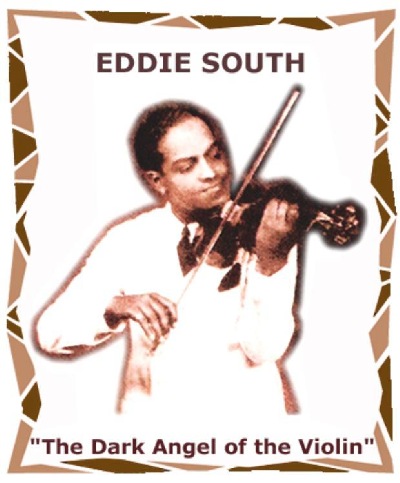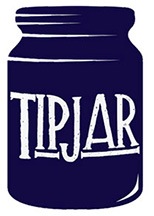
EDDIE SOUTH
The Dark Angel of the Violin
Largely forgotten today, violinist Eddie South traveled the world achieving modest popularity with a unique fusion of classical technique and gypsy influences with hot jazz sensibility.
In his day he was billed as “The Dark Angel of the Violin.”
Exploring the music and career of brilliant violinist Eddie South.
EDDIE SOUTH_Pt. 1.mp3
MY! OH MY! -- Eddie South and his Orchestra, 1933
SWEET GEORGIA BROWN -- Eddie South duet with Django, Paris, 1937
IDAHO -- Eddie South, 1944
VOICE OF THE SOUTHLAND -- Eddie South, 1927
LADY BE GOOD -- Eddie South Quintet, NYC 1941
EDDIE SOUTH_Pt. 2.mp3
OLD MAN HARLEM -- Eddie South, 1931
GOTTA GO -- Eddie South, 1933
AT THE BALL -- Eddie South, previously unissued, 1934
TZIGANI IN RHYTHM -- Eddie South, Standard Transcriptions, 1944
EDDIE SOUTH_Pt. 3.mp3
EDDIE’S BLUES -- Eddie South, 1937
FIDDLE BLUES -- Eddie South, 1937
DINAH -- Eddie South, 1937
HONEYSUCKLE ROSE -- Eddie South, Holland 1938
ON THE SUNNY SIDE OF THE STREET -- Eddie South, Holland 193
STOMPIN’ AT THE SAVOY -- Eddie South Quintet, 1941
DR. GROOVE -- Eddie South, Standard Transcriptions, 1944
EDDIE SOUTH_Pt. 4.mp3
MAD MONK -- Eddie South, Standard Transcriptions, 1944
RHAPSODY IN BLUE -- Eddie South, Jubilee (AFRS), 1944
SOLACE -- Eddie South, Standard Transcriptions, 1944
Born in Missouri in 1904 but raised in Chicago where he studied Classical violin, Eddie South was a child prodigy. But as a black man any opportunity in legitimate classical music at that time was barred to him. So instead he became active in Vaudeville, in early Jazz, and was much influenced by central European gypsy music after visiting Hungary in the late 1920s.
1920s
Between 1923-27 South worked in some of the better musical aggregations in Chicago such as the theater orchestras of Charles Elgar and Erskine Tate. He launched his own group there in 1927 at Club Alabam; that year his “Alabamians” recorded for Victor Records. Thereafter he led bands under his own name for more than three decades.
Though I emphasize his Jazz side, much of South’s performing was more Popular in nature such as his romantic adaptations of light classics and Hungarian gypsy music. Eddie’s jazz records were basically small string bands with piano and drums, though for some of his residencies he did have larger bands with plenty of horns.
EDDIE SOUTH & GYSPY MUSIC (mp3)
1930s
From the mid 1930s on he was in great demand in a wide range of venues, appearing and recording in Hollywood, Chicago, New York and Paris, frequently performing and recording in Europe: France, England and Holland. It was during a visit to Hungary in the late Twenties that he became fascinated with the violin music of the gypsies.
The expressive lyricism of gypsy violin music made a deep impression on South, and remained a powerful influence for the rest of his life. However, I suspect that this inclination (and his classical tendencies) conspired to marginalize his popularity among Jazz and Popular audiences. Nonetheless, central European repertoire and gypsy tunes -- what is known as tzigane (or cigany) -- was a mainstay of Eddie South’s personal musical style.
South also hooked into another aspect of Gypsy tradition during his many lengthy stays in Europe, joining up with Django Reinhardt -- who was transforming his Manouche gypsy tradition into a fresh new Jazz style with Stephane Grappelli in their Quintet of the Hot club of France. The result was some of Eddie South’s most spectacular collaborations and best pure jazz records, such as his exquisite 1937 duet with Django called “Eddie’s Blues” and several outstanding records of the Quintet with both Stephane and Eddie such as “Dinah” “Lady Be Good” and “Fiddle Blues.”
1940S & ‘50s
Through the ‘40s & ‘50s South continued to be heard widely on radio in the U.S.; held numerous residencies; and performed on Armed Forces Radio. He was even on Chicago television in the 1950s, and later in new York with such TV personalities as Dave Garroway, continuing to perform until a few weeks before his death in 1962.
Drawing from a broad palette of Classical music, Gypsy tzigane and Jazz, Eddie South’s distinctive dark tone, powerful bowing and immaculate violin technique continually drew new listeners enchanted by “The Dark Angel of the Violin.”
EDDIE SOUTH CONCLUSION (mp3)
Tip Jar
This site is free. But you can help sustain it, and encourage me with donation to the tip jar. Secure payment through PayPal is anonymous, except that I will see your e-mail address.
Donation $5.00
Donation $10.00
Donation $20.00
Donation $35.00
Donation $50.00
Donation: You decide

